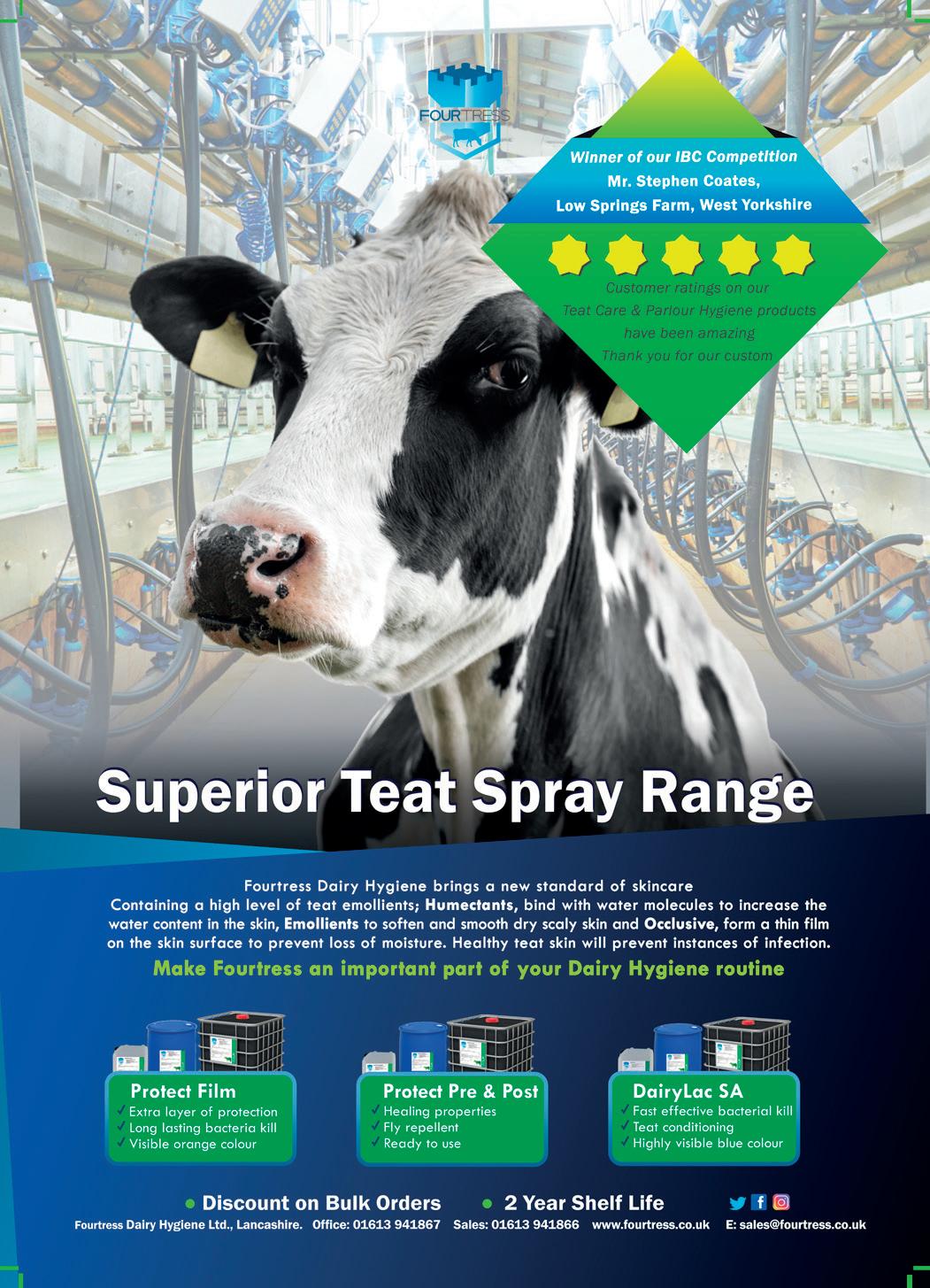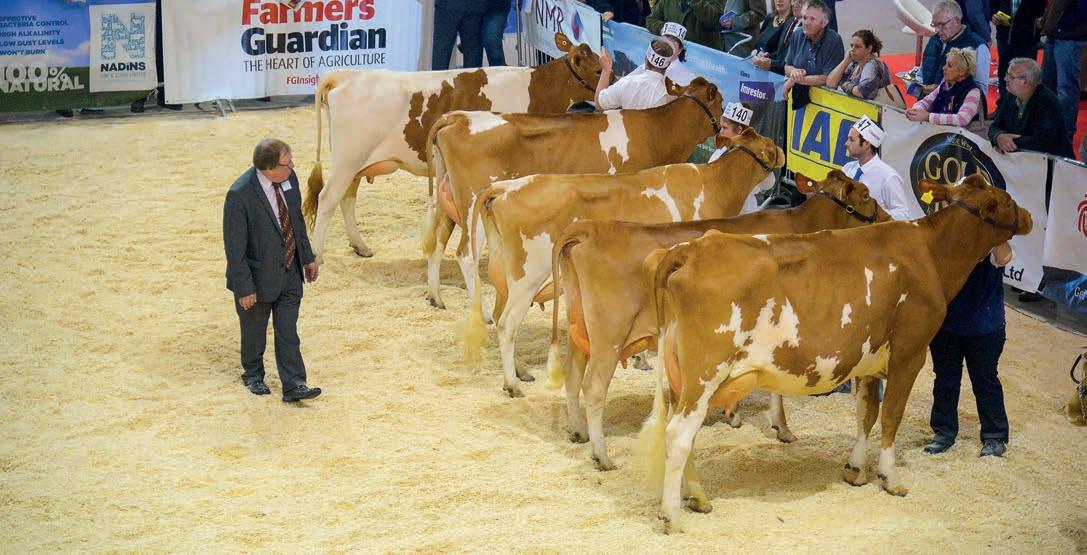
23 minute read
DAIRY SHOW PREVIEW
The Dairy Show is making its return on Wednesday, October 5, 2022, at the Bath and West Showground in Somerset. Katie Jones looks ahead to the event.
66 CHEESE AWARDS
Dairy produce showcase for British Cheese Awards 68 DAIRY
SHORTHORNS
Meet this year’s judge 74 JERSEY SHOW
Q&A with Duncan Hunter ahead of judging 76 MUCK SEMINARS
A word from the sponsor of this year’s show
Remaining at the show’s heart are the dairy cattle.
Visitors to this year’s Dairy Show can once again expect a showcase of the latest innovation, trusted merchants and rst-class stockmanship. e dairy sector is a fundamental part of British agriculture, says acting head of shows, Jess Chiplen.
She says: “We are in the heart of it here in the South West – within the sector are world-class farmers and agricultural companies who are responsible for pioneering new technology, genetics and practices.
“It is a privilege to host many of them here.” e event’s theme this year will be muck, with the focus on ways organic manures can be collected, stored, optimised and applied to maximise soil health and, ultimately, the performance of crops and grazing livestock.
Ms Chiplen says: “At a time when milk price and costs, such as feed and fertiliser, are so high it is important that ideas and knowledge are shared to capitalise on marginal gains and opportunities.”
Remaining at the show’s heart are the dairy ca le, with exhibitors travelling from all over the country to compete in a variety of breed classes before respective champions go head to head for the sought-a er supreme champion title.
Ms Chiplen says: “ e Ayrshire, Dairy Shorthorn, Guernsey, Holstein and Jersey breeds will all be well represented.” e Jersey Ca le Society of the UK and the English Guernsey Ca le Society will both be holding their national shows at the event.
Ms Chiplin says: “On top of that, we have calf classes and the popular showmanship competition. e la er is always a ne example of the incredible up-and-coming talent we have in the industry.”
For the rst time ever, the British Cheese Awards will be taking place at the Dairy Show, providing an impressive display of dairy produce, including cheese, bu er, yoghurt and cream.
Judging
Judging of the awards will take place on the day, with visitors able to view the display and take part in the all-important People’s Choice Award.
Ms Chiplen says: “We are delighted to be welcoming everyone back to the show. It is particularly exciting to encompass the British Cheese Awards, providing the perfect platform for producers to showcase the complete journey from farm to fork.”
Dairy Show
rWhen: Wednesday, October 5, 2022; gates open at 8.30am rWhere: The Bath and West Showground, Shepton Mallet, Somerset, BA4 6QN rTickets: Advance tickets are available at £15 per adult, increasing to £18 on the gate; students, with proof, will have discounted entry at £14; children under 15 years old will have free entry rMore information and to book tickets: bathandwest. com/the-dairy-show
An industry showcase
How much trace metal is your mineral actually supplying to your cows?
By Isabelle England, Ruminant Nutritionist, Trouw Nutrition GB Understanding mineral nutrition for dairy cows is an evolving science, with considerable advancements being made since the introduction of sulphate and oxide minerals in the early 20th century.
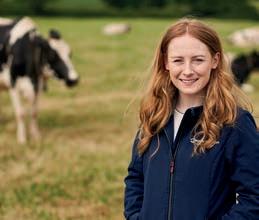
New categories of trace minerals have been established along with a greater understanding as to how mineral supplementation impacts animal efficiency, farm profitability and sustainability. With the latest guidelines to dairy cow nutrition recently published by NASEM, which incorporates an ever-growing body of independent research, means 2022 is the year to get mineral nutrition right. The research confirms the absolute need to deliver both the most bioavailable form and optimal levels of trace minerals to support animals’ requirements while reducing environmental impact. Mineral bioavailability refers to the proportion of the mineral consumed which is absorbed by the animal. Many factors influence mineral bioavailability, but the most defining factors are the solubility, bond strength and structure. The use of inorganic minerals such as sulphates and oxides have dominated the market for many years and as a result of their extremely low bioavailability, recommendations have been based on levels which greatly exceed actual requirements. Oxide trace minerals such as zinc and manganese are inexpensive, yet the mineral contained within their structures is largely insoluble, meaning bioavailability is generally very low and variable. This makes it all but impossible to actually determine the amount of oxides required to meet animals’ needs. Sulphate minerals such as copper suffer several negative side effects, including their high reactivity. When copper sulphate comes into contact with water, either in damp conditions or the rumen, the mineral is released meaning it may bind with other nutrients known as antagonists. Once bound the mineral is no longer available for the animal to use, making accurate mineral balancing in a ration difficult. To compensate for these downfalls the newest trace mineral technology comes in the form of hydroxy trace minerals (IntelliBond) which support both optimised bioavailability and economics. These minerals have a unique structural composition which means they are insoluble in the rumen and dissolve layer by layer in the intestines for a slow, steady and consistent release of mineral. As a result, the minerals are less susceptible to antagonism and greater amounts are delivered to the intestines for absorption into the bloodstream and actual use by the animal. Optimised absorption also means less environmental excretion due to their improved bioavailability. Research shows IntelliBond minerals are 2x more bioavailable than inorganic sources, meaning 1000mg/kg copper IntelliBond supplies the same bioavailable copper as 2000mg/kg copper sulphate with fewer negative interactions and less risk for greater reward. Now that a greater emphasis is placed on efficiently meeting animal requirements, research validated products are becoming more important. IntelliBond enables producers to work towards a responsible mineral strategy and offers a unique and technologically advanced solution to help drive superior animal performance whilst also delivering environmental benefits due to a reliable and predictable supply of minerals.
A responsible mineral strategy:
• Addresses real requirements • Maximises animal absorption • Increases overall efficiency • Minimises nutrient destruction • Considers environmental impact
Bioavailability is not the only benefit to the use of IntelliBond minerals. Follow on over the next 3 issues to discover how ration availability, palatability, quality and sustainability are all positively influenced. In the meantime, if you want to start to take action now reach out to us at
trouwnutrition.co.uk/intellibond
Welcome return for the British Cheese Awards
Aer a two-year hiatus, the British Cheese Awards is set to return this year, and for the rst time ever, the awards will take place at the Dairy Show. e awards will include impressive displays of dairy produce, including cheese, bu er, yoghurt and cream.
Judging of the awards will take place on Wednesday, October 5, with visitors at the Dairy Show being able to view the display and take part in the all important People’s Choice Award.
Julius Longman, chair of the British Cheese Awards at the Bath and West, says: “We are delighted to nally be hosting the British Cheese Awards again, particularly with a brand new date later in the year which will provide the perfect platform for producers to showcase their products just in time for Christmas.” e British Cheese Awards is now in its 28th year and continues to a ract entries from more than 75% of UK producers.
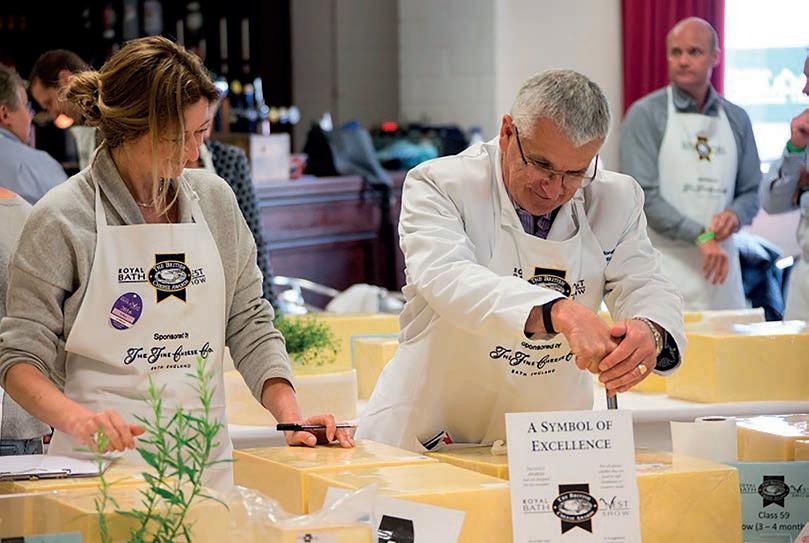
Judging at the British Cheese Awards.
JULIUS LONGMAN
Come and see us at The Dairy Show.
The Virus Shield Team will be at the Bath and West Showground 5 October 2022. Enquire now for a golden ticket.
Potential benefits with our products:
• Less antibiotic usage • Increased profits • Improved animal welfare • Reduced animal mortality • Increased productivity and yield • Reduces carbon footprint • Reducing odours

All of this in one box and much much more
To find out how we can help you, call 01225 983710 or visit www.vsbiosciences.com Previous winners
JLast held in 2019, the British Cheese Awards saw the supreme champion title go to White Lake Cheese, for the third year in a row, a first in the awards’ history.
The 2019 winning cheese was the English Pecorino, which is made from sheep’s milk, by Roger Longman and Pete Humphries, at White Lake Cheese, Pylle, Somerset.
It was named the top cheese from just under 900 cheeses which were entered into the 2019 awards, which were held on the first day of the Royal Bath and West Show at Shepton Mallet, Somerset.
English Pecorino is made from thermised sheep’s milk with vegetarian rennet. It has a sweet smooth, long-lasting creamy flavour with subtle nutty notes. It is washed in brine three times a week and is matured for about six months.
Mr Longman, a third generation farmer and cheesemaker at White Lake Cheese, says: “The British Cheese Awards is a great competition for artisan cheesemakers. The level of judging is superb as the judges are extremely experienced, they are the best in the UK, and we really value the feedback we get from them.”
Goats
White Lake’s home is set at Bagborough Farm, near to the Glastonbury Festival site in Somerset. Milk from Mr Longman’s herd of Toggenburg, British Apline and Saanen goats is used to produce goats cheese. A local Guernsey herd provides the cow’s milk and the sheep’s milk is also sourced from a local flock.
In 2017, White Lake Cheese won the supreme award with Pave Cobble and in 2018 it won for Sheep Rustler. Both are sheep’s cheese.
Renowned dairy breeder and judge Paul Harrison, from Northumberland, heads to this year’s Dairy Show to judge the Dairy Shorthorn classes for the first time. Katie Fallon finds out about his success within the industry.
Dairy Shorthorn judge set to make Dairy Show debut
Surrounded by Northumberland countryside, Paul Harrison, his wife Ann and their two daughters Joanna and Victoria, milk a 100-cow closed herd of pedigree Holsteins and Dairy Shorthorns at Breckney Hill Farm, near Heddon-on-the-wall.
Originally residing in the North Tyne Valley, Mr Harrison’s parents initially milked British Friesians, establishing their Chishillways pedigree British Friesian herd in 1958.
It was in 1972 that Mr Harrison and his parents moved to Breckney Hill Farm as tenants, which they later purchased in 1996.
Following a stint away at college and ve years working at the Hunday Herd, at Peepy Farm in Northumberland, Mr Harrison returned home to work on the farm in 1983 when the family began introducing Holstein genetics into the herd.
But it was not until 1989, following Mr and Mrs Harrison’s nuptials, that they decided the farm needed a new direction.
First cow
In the spirit of trying something new, they purchased their rst Dairy Shorthorn cow.
Mr Harrison says: “Ann used to work at George and David Dent’s dairy farm in Kirkby Stephen, milking Dairy Shorthorns in their Winbrook herd, so that is where we bought our rst Dairy Shorthorn, which established our Breckney Shorthorn herd.”
Following this, the couple bought a cow from Sam Wilson at Castle Douglas, called Screel Goldie 6, which marked the beginning of a very successful Goldie line for Mr and Mrs Harrison.
Mr Harrison says: “Her daughter Breckney Goldie was such an excellent cow that she won classes at the Great Yorkshire Show several times.
“We had her all set up for the Dairy Event at Stoneleigh, but then foot-and-mouth broke out, so we could not take her. She went on to develop E.coli mastitis and we thought we
Farm facts
r67 hectares (165 acres) of grassland rSilaging begins in mid-May with three cuts taken annually rMilk sold to First Milk rHerd averaging 8,500kg at 3.2% protein and 4% butterfat rCalves fed on whole milk and weaned at eight to nine weeks of age rBull calves are sold at 10-12 weeks of age at Carlisle Auction Mart rHeifers served at 16 months of age to conventional Holstein and Dairy Shorthorn semen
PICTURES : Adrian Legge
Comfortably Clean
cows choose...
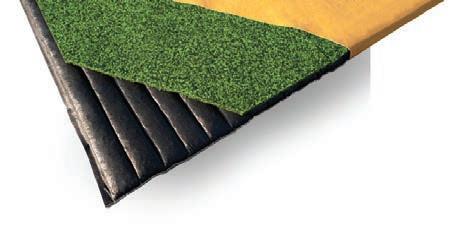



The Cowcoon Hybrid Stall, Puts You In Control.
T: +44 (0) 2870 868430 • Charlie Sutcliffe (North) 07703 679023 charlie@wilsonagri.co.uk • Matthew Evans (South) 07922 422556 matthew@wilsonagri.co.uk cowcomfort@wilsonagri.co.uk www.wilsonagri.co.uk
were going to lose her, but she survived and we decided to ush her.”
From two ushes, 23 embryos were collected, with 11 heifer calves and three bull calves being registered.
Mr Harrison says: “One of those bulls went onto to be an arti cial insemination bull, Churchroyd Goldwin.
“His semen is still available today through Red Ca le Genetics and he went on to sire the winning cow of the Great Yorkshire Show in 2017.” at one Goldie cow went onto develop the foundations of the Breckney Shorthorn herd which are still present today, with all four Dairy Shorthorn ca le Mr Harrison took to the Great Yorkshire Show this year being from the Goldie family.
Today, Mr and Mrs Harrison run 30 pedigree Dairy Shorthorns and 70 pedigree Holsteins under their Breckney and Chishillways pre xes. With no sta , they run the farm between them, with help from their daughters and friends when needed.
Mr Harrison says: “Both daughters work away from the farm, but will always help whenever we ask.”
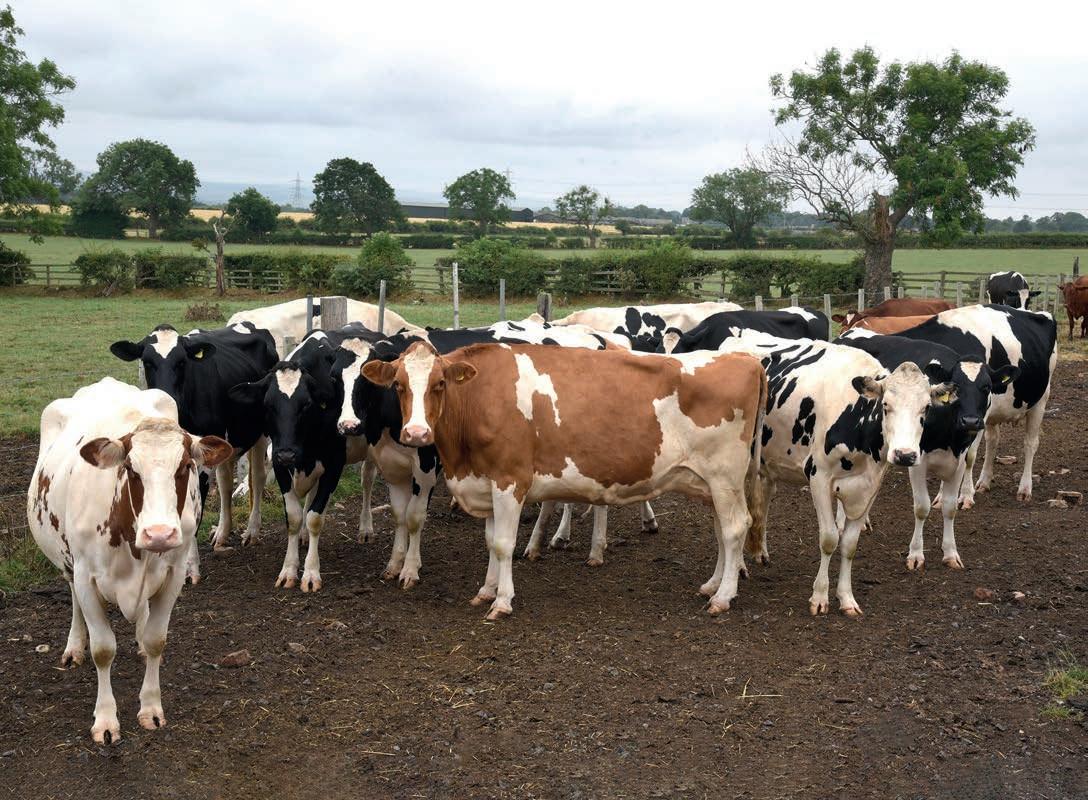
Parlour
e family milk through a 7:14 Fullwood herringbone parlour, with the herd currently averaging 8,500kg, at more than 4% bu erfat and 3.2% protein.
Cows are grazed from April until October and are fed self-feed silage through winter, which Mr Harrison says is a ‘simple system for simple people’. e herd operates at a high health status, with annual vaccinations for leptospirosis, bovine viral diarrhoea and regular blood sampling for Johne’s disease.
Mr Harrison says: “You can never ever say you are disease free, but we try to operate at the highest health status possible.”
Mr Harrison does all the breeding himself, with very li le beef semen used. All heifers are served at 16 months then followed up with a Holstein bull to catch anything which has not held.
He says: “We serve at 16 months to get natural growth, because when you are on a self-feed silage system you need robust cows. Also, the cows and heifers run together, so they need to be big enough to survive.”
Calving takes place all year round, with surplus newly
The dairy herd gathering for milking.
calved Holstein heifers sold monthly through Carlisle.
He says: “I have always bred for type not gures, because if you breed the right type, the milk will come. We have to breed functional cows with good feet and legs which sell well at market. If you breed good type, buyers will come back every time.”
Success
Regulars in the sale ring, Mr Harrison and family have also had great success in the showring, with Breckney Hill Farm claiming a vast number of rose es over the years.
Mr Harrison has been involved with both showing and judging for the last 40 years, with the showring having always been a part of his and his family’s lives.
He says: “It all started
Dairy Shorthorn in-calf heifers.
through my uncle. He wanted something to show at a local show, so my dad sold him one of our cows.
“I told Dad o for not selling him the best one, but he had method in his madness, as he told me he had not sold him the best because we were going to take the best and beat him.”
Having shown since the early 1970s, the family have been triumphant with their Holstein and Dairy Shorthorn herds.
As winners of the Holstein Friesian championship and inter-breed championship at the Great Yorkshire Show in 1996, they have also taken the national All Breeds Calf Show, Shorthorn championship in 2012 and 2013, junior and reserve champion at the Great Yorkshire Show in 2017, as well as championships at Dairy Expo and class winners at AgriScot. e family complete all the show preparation themselves, with Mrs Harrison taking charge of halter training and Mr Harrison responsible for clipping.
He says: “Our daughters have both competed in showmanship classes and have done really well across national competitions – they both really enjoy it.”
As a result of their showring success, Mr Harrison has been lucky enough to judge at many shows and competitions, travelling the length and breadth of the country.
His stockman’s eye took him further than British waters in 2018, a er being asked to judge at the Australian International Dairy week in 2019.
Mr Harrison says his Australian debut was complete luck, a er meeting an Australian judge at the Royal Cheshire County Show, he received a phone call 18 months later asking him to judge the Australian Illawarra Shorthorn ca le.
He says: “It was an amazing experience and I got to spend time looking at red ca le genetics while I was out there.
“I have since been asked to judge at the Royal Adelaide Show as soon as Covid-19 restrictions allow.”
A er building such a reputable presence in the judging arena, it is di cult to imagine a time when Mr Harrison was not judging.
However, it all began where most good things do, through his local Young Farmers’ Club, which saw him go onto represent the club at both county and national levels.
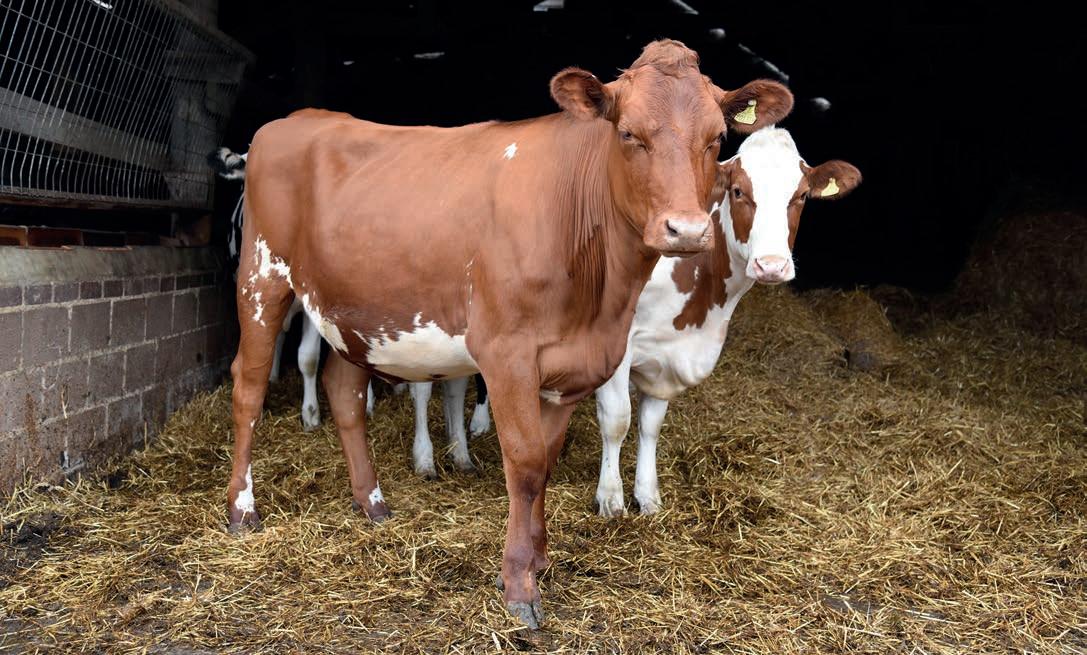
Representation
Mr Harrison also began representing the Northumberland British Friesian Breeders Club on both a local and national level.
Since these early days, Mr Harrison has gone on to judge inter-breed and breed classes at the Dairy Event, National Shorthorn Show, Royal Highland Show, All Breeds All Britain Calf Show and the Royal Show to name a few.
However, this year marks the rst year Mr Harrison will judge at the Dairy Show. Judging the Dairy Shorthorn classes, Mr Harrison says he will be looking for a well-balanced cow, with a lot of dairy strength, body and capacity, with good feet, legs and udders.
Having shown both Holsteins and Dairy Shorthorns over the years and being a self-proclaimed Holstein enthusiast with a passion for both breeds, Mr Harrison says the Dairy Shorthorn is the easier managed breed, with a greater drive to survive.
He says: “In all the years we have had Dairy Shorthorns we have never had to li one up. ey have that willingness to live and thrive, with so much vigour and ght in them.”
Other than virility, Mr Harrison says there is not much difference in breed performance, particularly production. However, he considers that large Holstein cows are harder to manage compared to the Dairy Shorthorns on his system.
He says: “A good cow is never a bad colour. I still look for the same traits in all of them as they must have good feet, legs and udder. But it is the easy management and the ght to survive I like about the Dairy Shorthorn.”
The Jersey Cattle Society of the UK is holding its national show at this year’s Dairy Show. Here, Hannah Park speaks to Duncan Hunter, who will be taking to the ring to judge the breed.
Meet the Jersey judge

Duncan Hunter, owner of Hunter Dairy Consulting based in Hertfordshire, has judged at a number of xtures across the UK as well as overseas and this year’s assignment at the
Dairy Show will be the third time he has judged at the event.
We nd out more about the judge and what he will be looking for.
QCan you explain a bit about
your dairying background?
AI was brought up on a dairy farm and had an Ayrshire and Holstein herd up until 2011 when the decision was taken to disperse.
A er this, I worked as breed manager at the Ayrshire Ca le Society until 2019 before se ing up my own dairy consultancy business which specialises in developing breeding plans and diversi cation projects for dairy farmers around the country.
QWhich shows have you
judged at in the past?
AI am lucky enough to have done a lot of judging over the years in the UK and overseas at Ayrshire and Jersey shows, as well as many interbreeds.
Alongside many national and local shows around the UK in both ca le and showmanship sections I have judged internationally out in Australia, South Africa, Sweden, Finland, where I judged Jerseys at Finn Dairy Expo in 2018, and Latvia.
In 2017 I judged Jerseys at the Royal Jersey Summer Show on Jersey, which was probably one of the biggest sections in terms of numbers I have ever judged.
QWhat will you be looking for
in your champion?
AI am ultimately looking for longevity. I want to see animals which excel in their functional traits that will aid them to live long and healthy lives.
I will be looking for animals with balance and correctness, showing me dairy quality with strength, along with strong mammary traits and good legs and feet.
QWhat has been your judging
highlight to date?
AIt has been a real honour to judge at all the events I have been asked to, but one of my most enjoyable experiences has to be when I judged in Jersey at the Royal Jersey Summer Show in 2017.
You could not fail to be impressed by the sheer numbers and quality of Jersey ca le forward, especially when considering the size of the island.
QHow do you view the dairy
sector as an industry at the moment?
AWe have experienced years of frustration and di culty as an industry.
Many of those who have survived the hard times have had to look to diversify within their businesses in order to survive, but equally it has been di cult for people to reinvest with the milk prices of the past.
We have seen a big increase in milk prices now but at the same time we are seeing a huge increase in input costs.
Looking ahead, I think all dairy businesses will need to commit to having sustainable goals in the future and environmental sustainability is set to continue to be high priority.
Also up there is encouraging young people, the next generation, into the sector.
Ultimately, as an industry, we must be open-minded, forward thinking and ready for change.
QWhat role do agricultural
shows have in a modern dairy industry?
AFrom local shows to county and national events, agricultural shows are a way of showing the public what the farming industry is all about and it is important they keep this aspect.
Shows are a platform to show people how well looked a er animals are in this country and demonstrate that we have some of the highest animal welfare standards in the world.
Not only that but they are a platform for farmers to get out, understand that they are not alone with any issues they may have and to see and discuss new concepts that may improve their businesses.
For those exhibiting, there is not a be er shop window.

I want to see animals which excel in their functional traits, says Duncan Hunter.
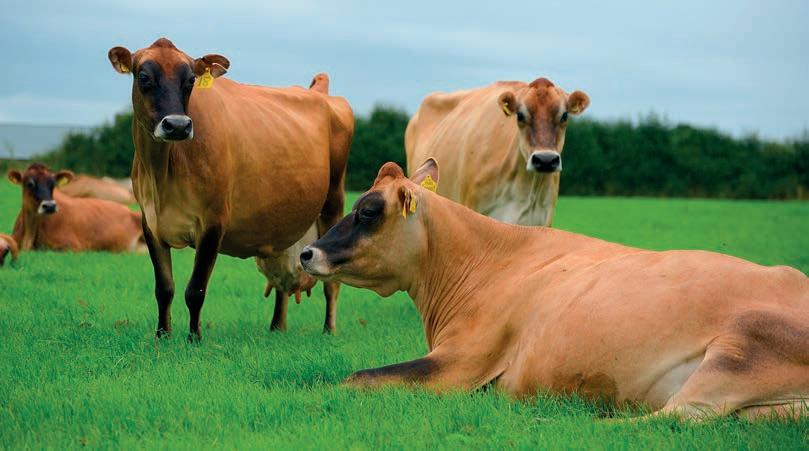
The Dairy Show will once again feature a series of seminars with the theme for this year’s programme being ‘muck’. Dairy Farmer reports.
The seminars at this year’s event are sponsored by EnviroSystems, with the company also presenting in two of the timetabled slots.
With a passion for slurry, producing and supplying SlurryBugs slurry inoculants to the UK and abroad since 2003, EnviroSystems jumped at the chance to sponsor this year’s seminar programme, says EnviroSystems’ founder and managing director Liz Russell.
She says: “To improve soil health and increase crop yields, the best place to start is with slurry.
“By properly understanding the composition of slurry and, in particular, the various forms of nitrogen within it, it allows farmers to optimise the amount of nutrients made available to their plants and maximise crop yield, without being wasteful or leading to over nitri cation.”
Philosophy
is ts perfectly into EnviroSystems’ BioCircle philosophy whereby everything a ects everything on your farm.
To demonstrate the improvements that have been seen on farms across the UK, Mrs Russell will present the results of a review conducted by Dr David Townsend, head of research at EnviroSystems, which assessed the nutrient value of 250 slurry samples from a range of di erent UK farms, independently analysed by NRM laboratories.
Just over half of the farms in the study had treated their slurry with EnviroSystems’ SlurryBugs, while the rest had not undergone slurry additive treatment.
Overall, the analysis showed that treated slurry had higher ber 2021 prices), equivalent to around 20% more.
Mrs Russell will reveal that the treated slurry also had a higher average dry ma er content of 7% compared to 5.6% for the untreated. is was due to the solid brous crust being broken down by the bacteria’s enzymatic reactions, releasing smaller particulate ma er into the liquid section making a more homogenous slurry.
She says:“ e breakdown of the crust means slurry requires less ongoing agitation, therefore saving time and reducing diesel and wear and tear on machinery. e reduction in diesel and bought-in fertiliser also contributes to a reduction in a farm’s carbon footprint.
“At today’s prices, it takes 1,700 litres of milk to pay for one tonne of nitrogen fertiliser, compared to the 900 litres it took between January 2019 and June 2021.”

Muck-themed seminars at show
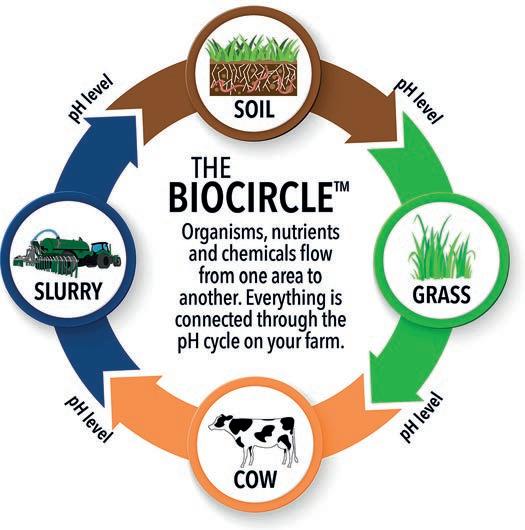
total nitrogen (+27%), phosphate (+45%) and potassium (+16%) levels compared to untreated slurry. Economically the fertiliser value of the treated slurry was worth £2.25/tonne more than untreated slurry (based on Novem-
rYou can listen to Liz Russell speak at 11.40am-12.10pm..
Ammonia emissions research and slurry analysis service
JEnviroSystems’ biochemist and Director Dr Henry Russell will present the progress to-date of a Defra-sponsored slurry emissions research project which started in August 2021.
The project’s principal aim is to deliver a cost-effective biological solution for dairy farmers’ slurry ahead of ammonia reduction targets due to come in 2027.
Dr Russell will share how EnviroSystems aims to reduce ammonia emissions while simultaneously increasing the homogeneity and the nutrient value of slurry - a critical area of focus due to the soaring cost of bought-in fertilisers.
He says: “This will be achieved through addition of naturally-occurring microorganisms using autodosing technology and it will represent the next generation of SlurryBugs slurry inoculants.”
Dr Russell will also introduce a new cutting-edge in-house slurry analysis service which is set to be officially launched at the show by EnviroSystems.
“It focuses on the fertiliser value of slurry and will help farmers to make the most of their slurry before spreading - allowing them to confidently reduce their bought in fertiliser applications.” rYou can listen to Dr Henry Russell speak at 12.10pm-12.40pm.

